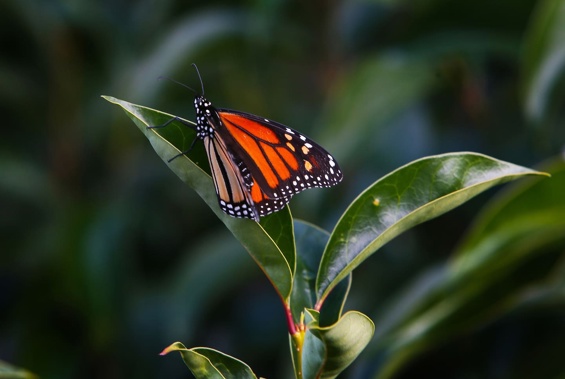
There has been a decline in monarch butterfly numbers at the Te Puna Quarry Park butterfly sanctuary - a trend echoed around the country, according to the Moths and Butterflies New Zealand Trust.
In a media release, the trust urged Kiwis to take care in their gardens to help the monarch population bounce back.
Monarch populations were preyed upon by the social wasp, a major threat to their population. But pesticides and the unintentional spread of butterfly diseases also contributed to the decline, the trust said.
Norm Twigge, former chairman of the trust, has seen a huge drop in numbers at the butterfly sanctuary at Te Puna Quarry Park.
“People don’t mean to kill them, but they are,” Twigge said.
“They protect them from wasps and other predators, but they do so in unsanitary conditions so in the end they are breeding butterfly diseases.
“Just as you find human diseases spreading in unhygienic conditions, so it is for all of our wildlife.
“If you can’t do it properly, you shouldn’t do it at all.”
Butterfly populations declining worldwide
Jacqui Knight, founding trustee, said butterfly populations were declining worldwide.
“Here in NZ we should be worried as well,” Knight said.
“Even more so – as most New Zealand people don’t even know about the beautiful species we do have. If you don’t know something exists, you don’t realise it is on its way to extinction.”
A monarch butterfly and caterpillar enjoy a swan plant. Photo / David Haxton
Knight said the trust was bringing the “beautiful” New Zealand red admiral back to Auckland where it had not been seen for at least 20 years. She said that was a result of Auckland being sprayed with insecticide to prevent the spread of the painted apple moth.
“Also, people are always amazed to learn about our beautiful forest ringlet – only found in New Zealand and with no close relatives, with numbers in serious decline.”
The trust has produced a list of dos and don’ts for people who are keen to help the monarch population bounce back in the summer and in future years.
“There are so many ways in which we can help our beautiful butterflies,” Knight said.
The trust’s dos and don’ts for helping the monarch population in New Zealand
DO buy twice as many plants and protect some for the monarchs of the future.
DON’T plant new ones in the summer heat. Wait until the caterpillars have eaten the leaves, prune the dead stems, and then plant the plant. (The plants will be stressed enough being eaten without having to cope with being transplanted.) Plant what’s left when the leaves have been eaten, but wait until it’s cooler (evenings) and keep it well-watered.
DO let caterpillars move themselves to the new plant. Put the new plant next to the old one, or cut the stems with caterpillars on and lay the stems at the base of the new plant. New plant(s) may not immediately appeal to your caterpillars and it could be that the toxicity is at a different level to that in the plant it was eating. Water the new plant well to rehydrate it.
DO grow your own plants from seed – that way you will know for sure whether the leaves are safe for caterpillars.
DO grow plants on from previous years so that they are in their second season and over 1m tall. If they are fertilised, watered and mulched, the growth in the spring and summer will almost keep up with the caterpillars.
DON’T remove seedlings that pop up in the wrong place. They can be left until you need food. Cut the stem close to the roots and split the cut stem before putting it in a container of water. Stand the container next to the plant.
NEVER feed them alternative foods such as pumpkin, cucumber or other members of the cucurbit family. Monarch caterpillars are meant to eat milkweed (e.g. swan plant) and many will not enclose into healthy butterflies when fed the wrong food. There is also a risk of doing long-term damage to their internal systems.
DON’T move or disturb caterpillars when they are moulting. Caterpillars shed their skin (moult) five times. They may choose to leave the plant as they sense that is where predators and parasites will find them. When they are moulting they will spin silk around themselves and disturbing them may kill them. Observe the life cycle but minimise handling. Monarchs have been undergoing metamorphosis for hundreds of years without our help.
DON’T use pesticides. Fly sprays, plug-in insect controls and flea collars on pets can kill caterpillars. Sunscreen and cosmetics on hands can also affect them. New carpets and drapes can sometimes contain insect-proofing. Swan plants are not indoor plants. The humidity indoors could alter the toxicity level in the leaves and could poison your caterpillars.
DO pinch out the growing tip when your plant is 15-20 cm, just above a node. The plant will now form two branches and bush out, creating twice as many leaves. A few weeks later pinch out the growing tip of the new branches. Also, a plant’s mission in life is to reproduce (set seed). Leaves feed caterpillars, flowers lead to seed. If you remove the flowers the plant continues to strive to fulfill its mission and as a result will feed more caterpillars.
DO think about growing Asclepias incarnata or swamp milkweed if you are not “frost-free” (i.e. cooler area). The plant will grow from a rhizome in the second and ongoing years, and will sprout soon after the last frost. It is very quick-growing and is a very popular nectar source as well.
DO consider growing A. curassavica, the tropical milkweed, if you are in a warmer area. There are two varieties – one has scarlet/gold flowers and the other has yellow flowers. These add a bit of variety in your garden.
DO put a notice in the Monarch Matchmaker Facebook group or in a network such as Neighbourly if you have no caterpillars or too many caterpillars.
DO remember that swan plants are poisonous so be careful when handling them. Monarchs store toxic steroids (known as cardenolides) from the swan plant and use them as a defence against some predators.
DO ask at your garden centre “is this plant safe for caterpillars?” and if that person doesn’t know, ask them to find out. Garden centre staff should be aware of how safe the plants are.
PESTICIDE USE
Commercial growers raise thousands of swan plants (a species of milkweed) and plants need to be in the best of condition when they are sold. Garden centres cannot sell plants covered with aphids, or bereft of leaves, so some growers use pesticides to protect their plants until they are sold.
Remember a female monarch can lay about 700 eggs (one was recorded as laying 1179). Caterpillars grow almost 3000 times in size over two weeks… so one day there are plenty of leaves and a day later the plant is just a stalk.
DO use garden centres that are confident their swan plants are pesticide-free, and that staff will be able to advise on nectar sources and host plants for other butterflies and moths.
Take your Radio, Podcasts and Music with you









